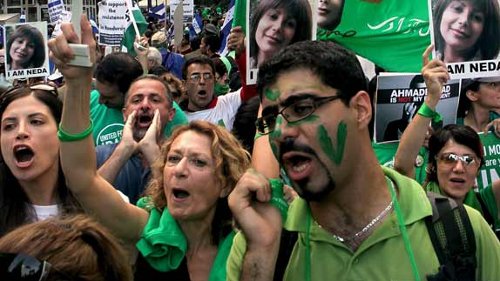
Iran’s nuclear ambitions, and its support for the Hizbollah and Hamas have been the key obstacles in President Obama’s rapprochement with Ahmadinejad’s government. Iranians who courageously opposed Ahmadinejad and his policies during the June 12th Presidential Election, however, expect a new direction in the rapprochement with Iran, one that shifts the focus to the Iranian people, and their human rights.
The protests that engulfed Iran last summer showed a new face of the country. Millions of highly educated, modern, and politically savvy young Iranians—60% of Iranians are under 30—together with parents and men and women of their generation, created a powerful non-violent movement for rights. Unique in the Middle East and much of the Muslim world, the movement revealed the potential Iran has for becoming a model for non-violent movements for democracy in a region infested by radicalism and violence. It is imperative that the United States and the West reward the Iranian model of social change, not just in words, but also in deed, in concrete policies that make a difference. These are a few examples with far reaching effects.
The clampdown that followed the June elections resulted in one of the largest waves of emigration since the 1979 Revolution. Thousands of journalists, photographers, political activists, and ordinary citizens who took part in demonstrations, or told the world about the atrocities of the government with their photos and stories fled to Turkey, Iraq, Pakistan, and other neighboring countries. They are seeking asylum and safety in the United States, Canada, or the European Union. As political repression continues in Iran, many more will leave in the weeks and months to come.
Those arriving in Turkey, for example, register with the police. They are dispatched to “satellite cities,” small towns often not hospitable to such foreign guest, after applying for protection at a local office of The United Nations High Commissioner for Refugees (UNHCR). A few high-profile cases will likely be reviewed with speed and leniency; however, many others will face different predicaments.
The asylum procedures are long, tedious, and riddled with preconceived prejudices and political considerations. It can take from months to years. Meanwhile, many asylum seekers live in dire conditions, and in constant fear of being followed by the agents of the Iranian regime, harmed, abducted, and taken back to Iran. The dangers and risks that made them flee their homes follow them in Turkey and other countries on the their journey to freedom.
While traveling in the secret communities of migrants from Iran three years after the nationwide student protests of July 1999, I met young activists living in abandoned buildings, sleeping in city parks, and facing unexpected hardships. Long after fleeing their homes, some were still waiting for asylum. Their conditions defied the claims of human rights protection in the West. A different approach to asylum for the fleeing Iranians is urgent and imperative.
The UNHCR review process, particularly in countries like Turkey and Pakistan, is in dire need for change. At this time of crisis, however, special considerations and expediency are needed in the case of the new Iranian arrivals, those who fear persecution for their contribution to the democracy movement last summer. In addition, the United States and EU countries can give the process a boost by allowing direct asylum applications with their embassies in Turkey and other transit countries, while also changing the conventional thinking that every Iranian applicant is a potential security threat. A constructive rapprochement will not be possible without a change in this mindset. Past practice has only hurt the chances of improved relations.
Iranians wishing to visit the United States on student or tourist visas, or scientific and cultural exchanges, have been subjected to humiliating profiling and treated with extra suspicion in recent years. The mistreatment worsened after September 11, 2001. Many would be visitors were denied visa solely for being born in Iran. Elderly parents wishing for a brief reunion with their children after long years of painful separation were denied visa. Science students with scholarship from American universities were denied entry on the fear of “using their new knowledge against America.”
The street protests last summer revealed the error in the prevailing understanding of the Iranians. For the past thirty years, Iranian people were seen through the prism of their government and its foreign policy. Their opposition to that government was largely ignored. While President Obama and other high-ranking officials have remarked on the great political and cultural divide between the people and the government of Iran, the American policy is yet to reflect this reality. Here too, concrete steps can go a long way in reaching out to the Iranians who long for inclusion and acceptance in the world.
The rapprochement requires widespread cultural exchange programs, and new facilities to initiate and expand visits by Iranian scholars, artists, intellectuals, and journalists. Relaxing tourist and student visa requirements, and granting scholarship to young Iranians will be instrumental in normalizing the relationship with the people of Iran, and gaining their respect and trust. These and similar actions will prove a lot more effective than the current funding of pro-American opposition forces, or the anti-government radio and television stations.
(article from Foreign Policy Journal)

